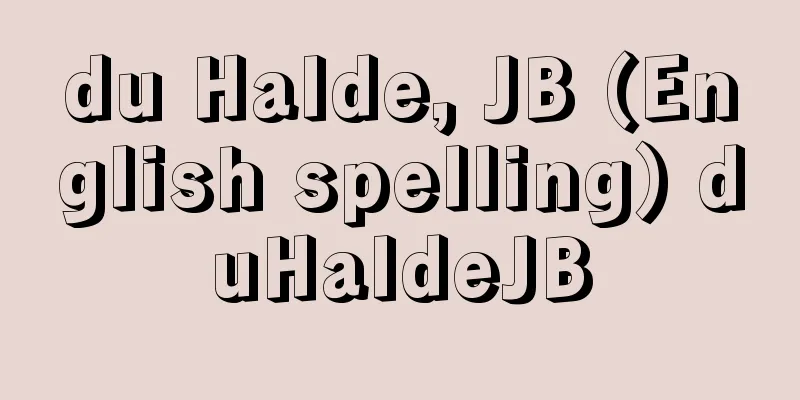Creation of a new family name - Soushikaimei

|
In 1939 (Showa 14), when Japan ruled Korea, Koreans were forced to change their surnames to Japanese names. This was done by amending the "Korean Civil Code," a government ordinance (order from the Government-General of Korea) on the handling of civil law in Korea. The "creation and name change" was divided into "creation" where a Japanese-style surname was created, and "name change" where the name was changed, with "creation" being compulsory and "name change" being optional. However, surnames were not erased or changed, and both "surname" and "honkan (family name)" were recorded in the family register, but from this point on, "surname" became the official name for Koreans, and the previous "surname" was treated as a common name. Incidentally, "surname" here refers to the "family" in the "family system" that existed under the Meiji Civil Code until 1947 (Showa 22). As part of the assimilation policy and the policy of making people subjects of the Imperial Nation by the Government-General of Korea, they attempted to reorganize the Korean family system, which placed emphasis on blood ties to ancestors, into the Japanese "family system." [Takei Hajime] Korean namesOriginally, Korean names consisted of "honkan," "surname," and "given name," and are said to have originated in the Goryeo Dynasty. For example, in the case of the 18th President of South Korea, Park Geun-hye, her honkan was "Goryeong," her surname was "Park," and her given name was "Geun-hye." "Hongkong" is the place of origin of the ancestor of a clan, so for example, even if they are the same Kim family, if they come from different clans, they are not of the same clan. The 15th president of South Korea, Kim Dae-jung, comes from Gimhae, and the 14th president, Kim Young-sam, comes from Kimnyeong. "Surnames" are names that refer to the lineage of the father's side, but there are only a few of them, and according to the 2000 South Korean census, there are only 285 unique Korean surnames. The most numerous are Kim, Lee, Park, Choi, and Jeong, which alone account for 54% of the population. "Names" represent individuals, but in the case of men, they also represent the generation from the ancestor. For each clan and each generation, the characters to be used in names, called "Haengnyeolja," are determined and are to be used. Kim Young-sam's name has the character "Yeong" in the middle line, which means he is the 33rd generation from the founder. Since people with the same family name and family lineage are considered to be related, men and women with the same family name and family origin cannot marry (since the Constitutional Court ruling in 1997, marriages between people with the same family name and family origin have been recognized in practice, and since 2005, it has been recognized by law). [Takei Hajime] Changes in the family registration system in KoreaThe names of people who belong to each clan are recorded in a "family tree" that shows the clan's relationship to its founder, but it was only after the family registry system was established that the family name, surname, and given name all began to be registered. The family registry system in Korea has changed as follows: 1909 (Ryūki 3): The Civil Registration Act was enacted. This law was created under Japanese influence during the Korean Empire and is similar to the Japanese family register. It was only applicable to Koreans and became the prototype for the later Korean family register. 1910 (Meiji 43): Japan annexed Korea. Family registration continues to be governed by the Civil Registration Act. 1911 (Meiji 44): The Government-General of Korea issued an ordinance regarding the "Changes of Names of Koreans." This prohibited name changes that could be confused with those of Japanese people in the mainland, as this would make it difficult to distinguish between Japanese and Koreans. 1912 (Meiji 45) Korean Civil Law (Regulations): Korean customs were to be followed, rather than Japanese civil law, regarding family and inheritance. 1923 (Taisho 12) Korean Family Registration Act: Jurisdiction over family registries is transferred from the governors and county governors of prefectures (equivalent to prefectures in Japan) to the chief judges of local courts (equivalent to district courts) or senior judges of their branch offices. 1939 (Showa 14) Revision of the Korean Civil Law: The "creation of surnames" was carried out and the "family system" was introduced, which meant that husbands and wives were given the same surname and adoption of children with different surnames and adoption of sons-in-law was also permitted. [Takei Hajime] The reality of creating new family namesIn order to create new family names, Koreans were forced to adopt a new surname. The set surname was to be notified by the head of the household between February 11 and August 10, 1940 (set surname). If no notification of a new surname was made, the family name of the head of the household was used as the surname (legal surname). Example of a created family name: Head of household: Lee Gyu Cheol/family name Hamheung → Family name: Kono Gyu Cheol/surname and family name Hamheung Lee Wife: Park Chun Gyeong/family name Miryang → Family name: Kono Chun Gyeong/surname and family name Miryang Park When creating surnames, some families established Japanese-style "family names," but many added a character to their family names or took names derived from their honkan. The Government-General emphasized "Naisen Ittai," but at the same time, they were led to do so out of a need to distinguish between Japanese and Koreans, and the Koreans themselves also wanted to maintain their clan groups. There was also an intention to resist Japan by establishing Korean-style family names. On the other hand, a "name change" required court permission, but the Government-General was not keen on name changes. This was because changing to a Japanese-style name would make it difficult to distinguish between Japanese and Koreans. Some people, such as the 5th to 9th president Park Chung-hee, changed both their first and last names to Takagi Masao, but many did not change their names, such as Kim Dae-jung who changed his name to Toyoda Dae-jung. [Takei Hajime] Revival of Korean namesWhen Korea was liberated in August 1945, the creation of surnames ceased to be used in Korea. The U.S. military government, which controlled the southern part of the Korean peninsula, promulgated the "Korean Name Restoration Order" in 1946, legally restoring surnames, and similar measures were taken in the northern part of the Korean peninsula by 1946. In addition, all adoptions of sons-in-law that had been made before the liberation in 1945 were also invalidated. [Takei Hajime] "Setsuko Miyata et al., "Creation of Family Names and Renaming" (1992, Akashi Shoten)" ▽ "Naoki Mizuno, "Creation of Family Names and Renaming" (Iwanami Shinsho)" [Reference] | |Source: Shogakukan Encyclopedia Nipponica About Encyclopedia Nipponica Information | Legend |
|
日本が朝鮮を統治していた1939年(昭和14)に、朝鮮人の姓名を日本式の氏名に変えさせたこと。朝鮮総督府によって定められた、朝鮮における民事法の扱いについての制令(総督府による命令)である「朝鮮民事令」を改正して行われた。 「創氏改名」は、日本風の氏をつくる「創氏」と、名前を変える「改名」に分けられ、創氏は強制、改名は任意であった。ただし、姓名が消されたり変更されたりしたわけではなく、戸籍には「氏名」と「本貫(ほんがん)・姓」の両方が記載されていたが、これ以降、「氏名」が朝鮮人の公的な名前となり、それまでの「姓名」は通称として扱われることとなった。 なお、ここでいう「氏」は、1947年(昭和22)までの明治民法下でいうところの「家制度」における「家」を表す名称である。朝鮮総督府による同化政策、皇国臣民化政策等の一環として、始祖との血統を重視する朝鮮の家族制度を日本の「家制度」に組替えようとしたのである。 [武井 一] 朝鮮人の名前本来、朝鮮人の名前は、「本貫」、「姓」、「名」からなり、高麗(こうらい)時代に始まったとされる。たとえば、第18代韓国大統領、朴槿恵(パククネ)の場合、本貫は「高霊(コリョン)」、姓は「朴」、名は「槿恵」である。 「本貫」は宗族一族の始祖の出身地であり、たとえば同じ金(キム)氏でも本貫が異なれば同族ではない。韓国の第15代大統領、金大中(きんだいちゅう/キムデジュン)の本貫は金海(クムヘ/キメ)、第14代の金泳三(きんえいさん/キムヨンサム)の本貫は金寧(クムニョン)である。「姓」は父方の血統を継ぐ呼称であるが、その数は少なく、2000年に行われた韓国の国勢調査では、韓国固有の姓の数は285しかない。人数の多いほうから金、李(イ/リ)、朴、崔(チェ)、鄭(チョン)の順であるが、これだけで国民の54%に達する。「名」は個人を表すが、男子の場合は、始祖からの世代も表している。宗族ごとに、世代ごとに、名に使う文字である「行列字(ヘンニョルチャ)」が決められていて、それを使うことになっている。金泳三は「泳」が行列字で、始祖から33代目を表す。姓と本貫が同じ「同姓同本」の人同士は一族と意識されるため、同姓同本の男女は結婚できない(韓国では1997年の憲法裁判所判決以来、事実上同姓同本での婚姻が認められ、2005年からは法律上も認められている)。 [武井 一] 朝鮮における戸籍制度の変遷それぞれの宗族に属する人の名前は、宗族の始祖からの関係を表した「族譜」に記載されるが、本貫、姓、名のすべてを登録するようになったのは、戸籍制度ができてからである。朝鮮における戸籍制度は以下のように変わってきた。 1909年(隆煕(りゅうき)3) 「民籍法」制定。大韓帝国時代に日本の影響下につくられた法律で、日本の戸籍に類似している。朝鮮人のみ対象で、のちの「朝鮮戸籍」の原型となる。 1910年(明治43) 韓国併合 戸籍については、併合後も「民籍法」による。 1911年(明治44) 朝鮮総督府令「朝鮮人ノ姓名改称ニ関スル件」 内地人に紛らわしい姓名変更を禁止した。日本人と朝鮮人の区別がつかなくなるからである。 1912年(明治45) 朝鮮民事令(制令) 親族、相続については、日本の民法を適用しないで、朝鮮の慣習によるとした。 1923年(大正12) 朝鮮戸籍令 戸籍の管轄が、日本の県にあたる道の知事および郡守から、地方裁判所にあたる地方法院長もしくはその支庁の上席判事に移る。 1939年(昭和14) 朝鮮民事令改正 「創氏」がなされ、「家制度」が導入されたが、これによって、夫婦は同氏となり、異姓養子や婿養子も認められることになった。 [武井 一] 創氏改名の実際家の名称を新たにつくるために、朝鮮人の「創氏」は強制であった。設定した氏は、1940年2月11日から8月10日までの間に、戸主によって届けることとされた(設定創氏)。「創氏」の届けがない場合は、戸主の「姓」を「氏」とした(法定創氏)。 設定創氏の例 創氏にあたっては、日本風の「氏」を設定した家もあったが、多くは姓に1文字加えたものや、本貫に由来したものが多かった。総督府は「内鮮一体」を強調したが、その一方で、日本人と朝鮮人を区別する必要からそのように誘導し、朝鮮人側も宗族集団を維持しようとしたからである。また、朝鮮的な氏を設定することで、日本に抵抗するという意図もあった。 一方で、「改名」は、裁判所の許可が必要であったが、総督府は改名には熱心でなかった。日本風の氏名に変えると、日本人と朝鮮人の区別がつかなくなるからである。第5~9代大統領朴正煕(ぼくせいき/パクチョンヒ)のように高木正雄と姓名とも変更した者もいたが、金大中が豊田大中としたように、名前を変更しなかった者も多かった。 [武井 一] 朝鮮姓名の復活1945年8月、朝鮮が解放されると、朝鮮では創氏名は使われなくなった。朝鮮半島南部を支配していたアメリカ軍政庁は1946年に「朝鮮姓名復旧令」を公布して、法律上も姓名を復活させ、朝鮮半島北部でも1946年までに同様の措置がとられた。また、1945年の解放までに結ばれた婿養子縁組も無効になった。 [武井 一] 『宮田節子他著『創氏改名』(1992・明石書店)』▽『水野直樹著『創氏改名』(岩波新書)』 [参照項目] | |出典 小学館 日本大百科全書(ニッポニカ)日本大百科全書(ニッポニカ)について 情報 | 凡例 |
>>: Successive carriage - Sōjiunsō (English spelling)
Recommend
Ido tea bowl
This is a type of Goryeo tea bowl that was fired ...
Autointoxication - Jikachuudoku (English spelling)
A poisoning caused by the toxicity of products pro...
Vortex - Whirlpool
…This is called a vortex tube, and the thinner ve...
Hui - Pirate (English spelling) Hui
One of China's ethnic minorities. They have t...
Beilis, MM (English spelling) BeilisMM
...A blood libel case against Jews in the final d...
Zeng Gong (English spelling)
[Born] Tenki 3 (1019) [Died] Gentoyo 6 (1083) A Ch...
Sommer, F.
…Hittite was discovered to be a branch of the Ind...
Avestar
The holy book of Zoroastrianism. Written in Avesta...
Oxalis variabilis (English spelling)
… [Munemin Yanagi]. … *Some of the terminology th...
Dr. Caligari - The Doctor Caligari
German film. Directed by Robert Wiene. Produced i...
Rumex crispus (English spelling)
…[Kazumi Tsuchiya]. . … *Some of the terms that m...
Aerial perspective
…He recognized that straight lines do not exist i...
Gatun Locks - Gatunkoumon
" Las esclusas de Gatun " is one of the ...
Bonneval, CAde (English spelling) BonnevalCAde
…French nobleman born Claude Alexandre de Bonneva...
Tsukudō - Denko
The most common term for tenant farmers in China....









